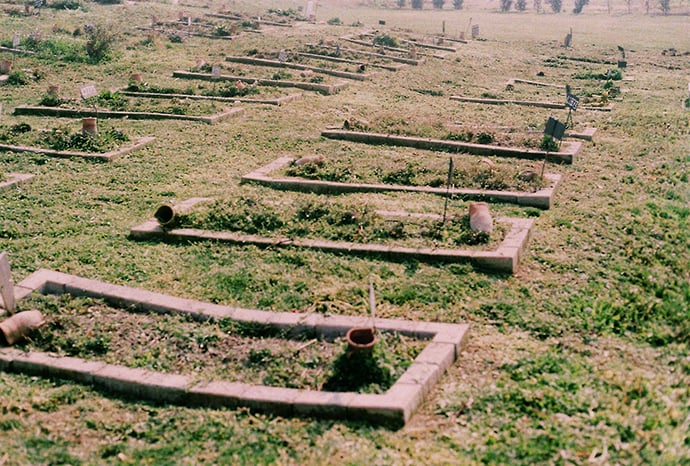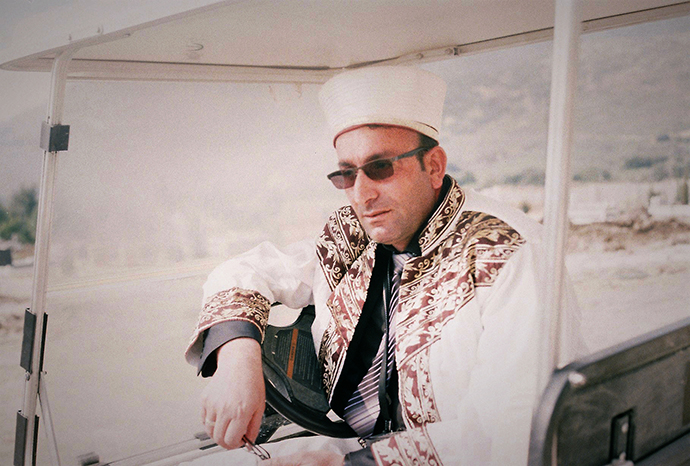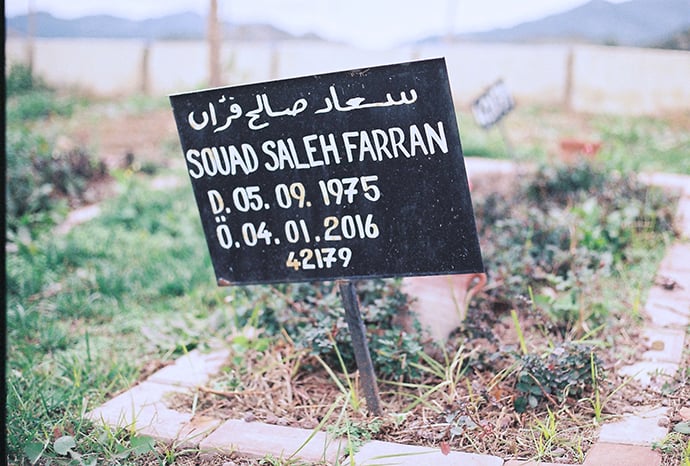
All photographs by Helen Mackreath
Doğançay Cemetery sits on a hill above the Aegean city of Izmir, in southwestern Turkey. On a bright day last winter, I traveled to the cemetery by bus with my friend and translator, Pelin Çakır, passing through winding old villages and high-rise construction sites, their walls marked with political graffiti. We arrived to find ordered rows of white gravestones stretching as far as the eye could see, undulating hills topped by electricity pylons in the distance.
From the entrance, where flowers are sold in buckets outside low-slung sheds, we walked for forty-five minutes through rows of tombs, finally reaching Island 412 in the upper corner of the graveyard. This island marks a caesura in a journey intended to end elsewhere, holding the unknown bones of one hundred and twenty souls, approximately forty of them children. Most are the bodies of people who drowned in the Aegean Sea, then washed up on the Turkish shore, unidentified.
The cemetery, which hosts almost fifty-eight thousand bodies, was neat and orderly, the graves marked by simple bricks in rectangular outlines. Two terra-cotta pots lay on either end, ready for flowers or water for birds. Each body was marked by a plaque with a five-digit number, the kabir numaras, which is assigned by the cemetery and sent to the individual’s file at the forensic laboratory. Following a DNA test at the shore, bodies are brought to the lab, then kept there for fifteen days in case a relative comes to claim them. If that doesn’t happen, the bodies are buried by Imam Kadir Çelenk, employed by Izmir Greater Municipality, which also oversees maintenance through the Department of Cemeteries.

When we met him, Imam Çelenk explained that he follows standard Islamic burial rites, washing each body and wrapping it in a kafan, a burial shroud. A body is placed on a stone inside a wooden casket in the central prayer area of the local mosque, and those who have gathered for the burial are asked to absolve the debts accrued by the deceased by the act of being attended at the funeral. A short time later, the body is removed from the wooden casket and buried with its face directed toward Mecca. There are typically only a few graveyard workers there to witness this final descent.
The most recent burials happened last October, after a small boat capsized off the Karaburun coast. The boat had been carrying thirty-five Iraqis and Afghans. Only one has been found. The presumed lone survivor, a thirty-year-old Iraqi woman named Mıhabat İsmael Ali, spent twenty-eight hours in the water before reaching the shore, aided by a life jacket. Local authorities found eight bodies in the water, and Ali identified each of them, including her husband and son. Her family members were flown back to the city of Zakho in Iraqi Kurdistan, their homeland, to be buried. The bodies of two Afghan children, who were later identified by DNA, were also flown home. Two bodies ended up on Island 412.
We walked between individual graves in Island 412. Some had identifying information: name, age, maybe a hometown, taken from a passport or identity card found on their body. We came across several names: Maisaa Nour AlDeen, a forty-one-year-old woman from Swaidaa, Syria; Doğan Çokçinar, an eighty-one-year-old Turkman. Two had simple stones bearing the names of children: Meryem Ahmedi, aged seven. Diyana Nazari, aged four. Their families traveled from Afghanistan a year and a half after their deaths to find them. They bought stone markers and inscribed their names but couldn’t afford the cost of repatriating the bodies.
There is one border that we all cross, the one between this life and the next. But the rituals we are afforded in death reflect the status we are given in life. The act of identifying and recollecting a life during a burial rite offers dignity to the deceased. Dying unidentified means being dispossessed of this possibility, being denied the recognition of a life’s struggles, hopes, loves.
Doğançay Graveyard has tried to resolve this. The cemetery provides a peaceful resting place and some form of identification, even if just a file number. Each body is recorded in the cemetery’s archive—a set of notebooks and Excel spreadsheets—and given a file number that is used in forensic department reports. These reports are sent to public prosecutors—offering some hope that the bodies could be identified in the future.
We spoke to Imam Çelenk as he was greeting visitors in a small one-room office at the entrance to the graveyard. Originally from Ardahan—close to the border with Georgia, on the opposite side of the country—he was posted to Doğançay by the Diyanet, the Directorate of Religious Affairs.

“Those people began the road with hope, but they had to leave their hopes on the way,” he said of the migrants buried around him. “Those children had no idea where they were going, what for, but they finally ended here.”
He was sympathetic to their plight, but as we spoke I realized that he believed several false stereotypes about Syrians, including that the Turkish government gives them preferential treatment. In an offhand comment he referred to Syrians receiving better access to health care than most Turkish people, refuting a suggestion that some of the children buried in Island 412 may have died due to poor health care.
The contradiction in his attitude marks an uneasy tension, common throughout the country, between humanitarian sympathy and pragmatic duty. Syrian refugees were first welcomed into the country in part along the lines of religious fraternity. But recently, as the refugee population has grown, anti-Syrian sentiment has proliferated, exacerbated in part by an economic downturn.
Later that afternoon, in a different part of the cemetery, we watched as the imam performed burial rites for a high-ranking Turkish military officer, whose face appeared on pins fixed to well-wishers’ lapels. Six officers in blue uniforms carefully placed his casket onto the shoulders of male family members. They carried the body in a procession, removed it from the casket, lowered it into an open grave, and scattered it with soil. He was buried in a new plot of graves dug in the sandy earth, a few hundred meters up the slope from the unidentified sector. Around a hundred people paid their respects, talking with long-absent acquaintances, some with bowed heads, a few with tears. The man was celebrated as a soldier, husband, and father.
In the distance, a short line of people slipped out of a gap in the wall into sheep-scattered fields, their faces fixed on the ground. Women in bright robes and men in laborer’s fatigues walked slowly, one after the other, without speaking, their heaviness apparent from afar. The imam later explained that they were a family of Syrians, visiting the grave of their child, buried among the unidentified bodies. They were too poor to afford a proper plot.
Pelin Çakır and Zeyneb Gültekin contributed reporting.


